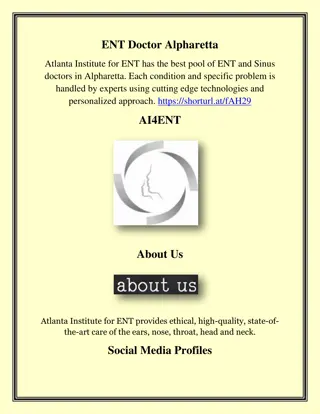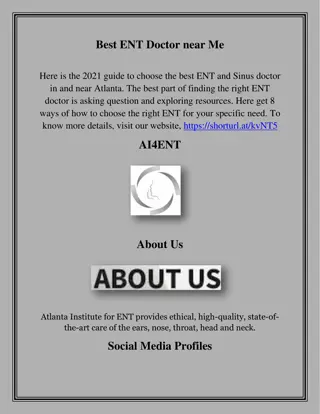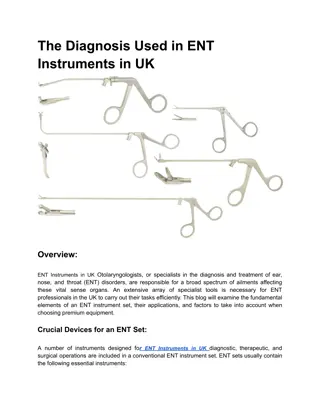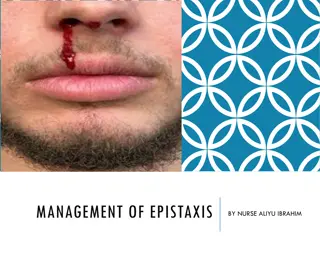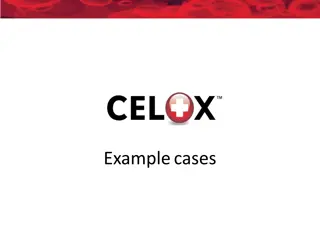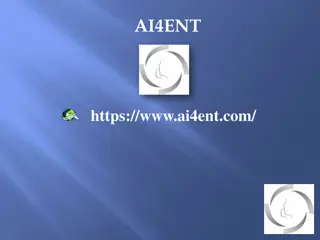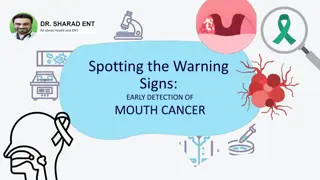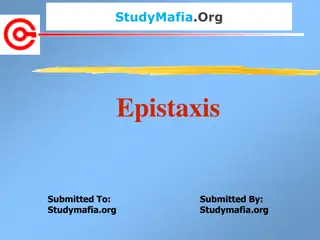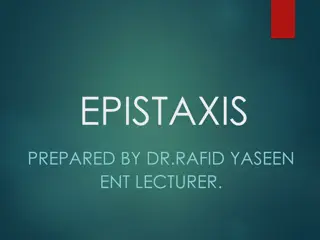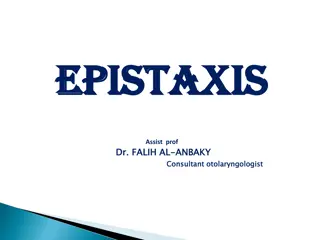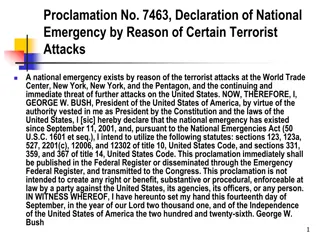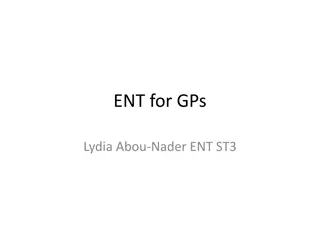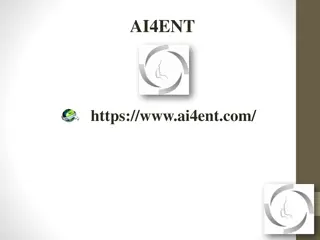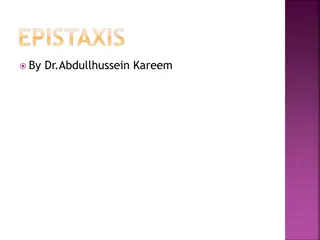Expert Guide to Managing Epistaxis in Emergency ENT Cases
This comprehensive guide covers the common ENT emergencies related to epistaxis, including management strategies, referral protocols, and essential procedures like cauterization and nasal packing. Learn how to properly assess and treat epistaxis cases to ensure patient safety and optimal outcomes in emergency settings.
Download Presentation

Please find below an Image/Link to download the presentation.
The content on the website is provided AS IS for your information and personal use only. It may not be sold, licensed, or shared on other websites without obtaining consent from the author.If you encounter any issues during the download, it is possible that the publisher has removed the file from their server.
You are allowed to download the files provided on this website for personal or commercial use, subject to the condition that they are used lawfully. All files are the property of their respective owners.
The content on the website is provided AS IS for your information and personal use only. It may not be sold, licensed, or shared on other websites without obtaining consent from the author.
E N D
Presentation Transcript
Common ENT emergencies Basic management How to refer Cases you should not miss
On call team 0875, 0709 For patients who need to be reviewed in ENT OPD within next few days; refer to RAC clinic RAC clinic Otitis externa, Bells palsy, FBs , Nose bleed , sudden hearing loss
Rhinology (Nose) Epistaxis Fractured nose Foreign body in Nose Acute sinusitis Orbital cellulities
Epistaxis Commonest emergency Primary Secondary Warfarin Aspirin Trauma Medical/Haematological Anterior or Posterior Bleed
Management Depends on presentation ABC Clear the airway, Stop the bleeding, Maintain circulation Clear the airway Good position with adequate light Protect yourself Remove clots with suction Apply co-phenylcaine
Stop the Bleeding Application of external pressure/application of ice pack Cautery for Anterior bleeding (Avoid in HHT) Nasal packing for posterior bleeding or a failed cautery
Cautery Prominent vessels on anterior septum Apply co-phenlycaine Cauterise with silver nitrate stick Apply naseptin cream to area (14 days)
Packing Profuse bleeding preventing cauterization Failed cauterization Posterior bleeding
Criteria for admission Patients requiring a nasal pack with the following Uncontrolled bleeding/posterior bleed Recent nasal surgery Significant blood loss/shock Major cardiac/respiratory disease Elderly/infirm/poor social circumstances Patients on warfarin Bilateral nasal pack Unilateral nasal pack in a fit patient: Discharge review after 24 hours to remove the pack
Fractured Nose Clinical diagnosis X-ray not necessary If nose is bleeding external pressure will suffice in most cases Exclude septal haematoma Assess for clinical deformity If obvious arrange ENT follow up within 5-7days
Foreign Body in Nose Children, Refer to ENT Co-operative patient remove with wax hook. Only one attempt allowed in A/E Non co-operative frightened patient refer to ENT On Call, same day
Foreign bodies Nasal FB
Periorbital Cellulitis= Pre-septal Orbital cellulitis= septal Previous history of sinusitis Recent URTI , nasal discharge Limited eye movement, Painful eye movement, visual defect S Pneumonia, H influenzae, Staph aureus,Anaerobes. Analgesia, IV Abs, CT, Ophthalmology Surgical drainage for abscess
Pre septal & Post septal Post septal infection Proptosis & Chemosis
Otology Acute Infections otitis externa & media Trauma Laceration not involving cartilage Laceration involving cartilage Haematoma of pinna Perforation of tympanic membrane Foreign body Facial nervepalsy Acute dizziness (vomiting, absence of neurological signs) Sudden hearing loss
Management Otitis externa/media Analgesia Externa Topical preparation (Gentisone HC, Sofradex) Insertion of Pope wick for closed canal If canal is filled with debris arrange for ENT follow-up for aural toilet Severe case refer to ENT On Call ( A&E Doctors) Media Oral antibiotics Arrange ENT Review
Facial nerve Palsy Lower Motor neuron facial palsy If spares the forehead, refer to the physician Bells palsy Ramsay Hunt Syndrome Acute otitis media trauma
Bells palsy Sudden With/without otalgia 55% of facial palsy Treatment: Eye care Steroid ? Anti virus
Ramsay Hunt Syndrome Blisters/Painful rash +facial weakess Tinnitus, dizziness, Sensory neural hearing loss, loss of taste Analgesia, Steroid, Antiviral
Facial palsy from ear infections Acute otitis media with or without ear discharge Urgent ENT referral IV Abs May require immediate surgical intervention Chronic otitis media Surgical treatment Otitis Externa Malignant Diabetes, pseudomonas outer ear infection, temporal bone necrosis + cranial nerve palsies Surgical debridement, Abs for 6 months
Traumatic Temporal bone fracture ( Ear CSF, blood): Neurosurgery Facial injury: Maxillofacial or plastic
Acute Dizziness DD Acute stroke Dizziness is a symptom of stroke in 50% of stroke presentations. A small stroke of the cerebellum or brain stem can present with isolated dizziness. CT is not sensitive, MRI is not practical at A&E setting
Dizziness in A&E ENT ?physician
Acute Dizziness 1.Vestibular neuritis Bad symptoms for ~2 days 2.BPPV Last less than 1 minute Feel normal in between or slightly dizzy Recurrent 3.Meniere s disease Sever dizziness for 20miutes or more Nausea / vomiting Tinnitus Pressure in the ear
Peripheral signs Horizontal unidirectional nystagmus Positive Head Thrust Test When the head is moved quickly in one direction, the reflex (i.e., the VOR) that moves the eyes toward the opposite direction is generated by the side the head moved toward. Thus a patient with vestibular neuritis of the left side will present with right-beating unidirectional nystagmus and have a positive head thrust test with movements toward the left side Central signs Tortional, Bidirectional, downbeating Nystagmus
Perichondrial Haematoma Follows blunt injury to the ear Collection of blood between auricular cartilage and perichondrium of pinna Required drainage and compression If left untreated cauliflower ear
Haematoma Aspiration + pressure bandage Incision and drainage
F.B Ear Not urgent Adults: Microscope Arrange a RAC clinic Small children often require GA
The Larynx/Pharynx Sore throat/Tonsillitis/Glandular fever Epiglotittis Ingested foreign body Neck trauma
Sore Throat Acute tonsillitis Glandular Fever Peritonsillitis Quinsy Epiglottitis (Dysphgia, Drooling, No signs)



